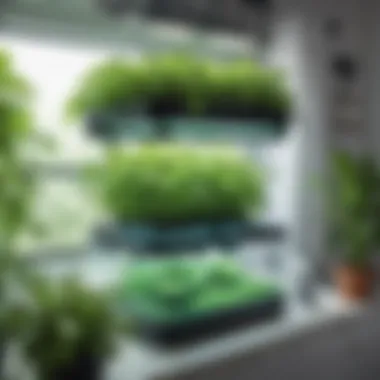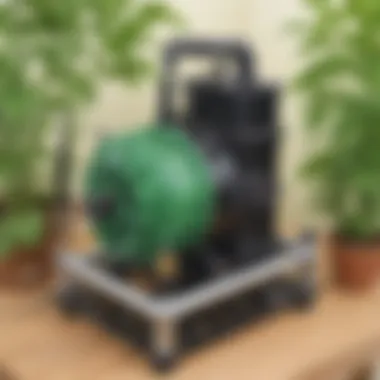The Ultimate Guide to Hydroponics: Setting Up a System at Home


Science Fun Facts
Hydroponics, a soilless method: Did you know that hydroponics is a method of growing plants without soil? It uses mineral nutrient solutions in water for plant growth. This technique has been used for centuries and continues to gain popularity due to its efficiency in plant cultivation. It's fascinating how plants can thrive without traditional soil!
Discover the Wonders of Science
Exploring Various Scientific Concepts In hydroponics, plants obtain nutrients differently: Unlike traditional soil gardening where plants get their nutrients from the soil, hydroponic plants receive nutrients directly from the water. This ensures that the plants get an optimal balance of nutrients precisely when they need them, leading to faster growth rates and higher yields. Isn't it intriguing how nature adapts to different growing conditions?
Science Quiz Time
- Interactive Quizzes Are you ready for a hydroponics quiz? Challenge yourself with questions like 'What are the primary benefits of hydroponic gardening?' or 'How does the nutrient film technique work?' Test your knowledge and delve deeper into the world of soilless cultivation.
Science Experiment Showcase
- Fun and Engaging Experiments Get hands-on with a hydroponics experiment! Create your mini hydroponic system using simple materials like a jar, water, nutrients, and seeds. Follow the step-by-step instructions carefully, and observe the fascinating growth of your plants without soil. Don't forget to prioritize safety by wearing gloves and handling nutrients cautiously. Enjoy the wonders of soilless gardening in your own home!
Introduction to Hydroponics
Hydroponics, in this comprehensive guide, emerges as a revolutionary method of cultivating plants without soil, thereby captivating the interest of gardening enthusiasts worldwide🌿. This section acts as the cornerstone, laying the foundation for successful hydroponic endeavors by delving into the intricacies and significance of this alternative growing technique. Understanding Hydroponics illuminates the core principles🌿 steering the practice closely investigated in the following subheadings.
Understanding Hydroponics
The basics of hydroponic gardening: At the heart of hydroponics lies a paradigm shift in traditional horticulture, eschewing soil and harnessing nutrient-rich solutions to support plant growth🍃. This fundamental departure from soil-based cultivation offers a host of advantages, such as precise control over nutrient uptake and optimal water usage, contributing to enhanced plant development🌱. The streamlined approach of hydroponic gardening bolsters plant health and accelerates growth rates, making it an appealing choice for modern gardeners seeking efficiency and sustainability in their growing practices. Embracing hydroponic basics unlocks a realm of possibilities for plant cultivation, underscoring its importance in this article's quest to empower readers with the knowledge needed for successful hydroponic systems.
Benefits of hydroponic systems: Venturing into the realm of hydroponic systems unveils a myriad of advantages that elevate this growing method above traditional soil-based counterparts🍀. The efficiency and precision offered by hydroponic setups translate into accelerated plant growth, increased yields, and resource conservation, revolutionizing the way plants thrive. The ability to tailor nutrient solutions to plant requirements ensures optimal health and minimizes waste, making hydroponic systems an eco-conscious choice for aspiring gardeners🌱. Exploring the benefits of hydroponics lays bare the transformative potential of this cultivation technique, underscoring its relevance in empowering readers to embark on a sustainable hydroponic gardening journey.
Choosing the Right Setup


Determine available space: Selecting the ideal hydroponic setup necessitates a thoughtful consideration of available space, a crucial factor shaping the feasibility and efficiency of the system's operation🏡. Assessing the spatial dimensions available for hydroponic installation lays the groundwork for seamless integration, ensuring that the chosen system harmonizes with its surroundings while optimizing plant access to light and nutrients. The judicious allocation of space for hydroponic endeavors sets the stage for robust plant growth and uncompromised system performance, underscoring the pivotal role of space considerations in this article's roadmap to successful hydroponics.
Selecting the appropriate system type: The quest for the perfect hydroponic system unfolds through a meticulous evaluation of various system types, each offering distinctive features tailored to different growing needs🌾. Navigating the array of hydroponic setups requires a discerning eye for system characteristics, such as nutrient delivery mechanisms, scalability, and maintenance requirements. Choosing a system type that aligns with one's gardening goals and available resources paves the way for a fruitful hydroponic journey, empowering enthusiasts to create a thriving indoor garden customized to their preferences. The selection of an appropriate system type signifies a pivotal step towards realizing successful hydroponic cultivation, emphasizing the importance of informed decision-making in this article's guidance on home hydroponics.
Setting Up Your Hydroponic System
Preparing the Growing Area
Cleaning and Disinfecting
Cleaning and disinfecting the growing area is a critical component of setting up a hydroponic system. By ensuring that the environment is free from contaminants and pathogens, you create a healthy space for plant growth. The process involves meticulous sanitization of all components, including reservoirs, tubing, and grow trays, to prevent the buildup of harmful bacteria and impurities. Implementing a regular cleaning schedule helps maintain optimal conditions for your plants, promoting growth and minimizing the risk of disease. While labor-intensive, this aspect of preparation is fundamental to the success of your hydroponic endeavor.
Ensuring Proper Lighting
Proper lighting is essential for the photosynthesis process, enabling plants to convert light energy into vital nutrients for growth. Choosing the right lighting setup ensures that your plants receive the appropriate spectrum and intensity of light for optimal development. LED grow lights, fluorescent bulbs, or high-pressure sodium lamps are popular choices, each offering unique benefits and considerations for hydroponic cultivation. By optimizing your lighting conditions, you create an environment that mimics natural sunlight, fostering healthy plant growth and increasing yield potential.
Assembling the Components
Installing Reservoir and Pumps
The installation of the reservoir and pumps is a critical step in assembling your hydroponic system. The reservoir serves as the central hub for nutrient storage, while pumps help circulate the nutrient solution to your plants. Selecting an appropriately sized reservoir and efficient pumps is crucial for maintaining a stable and consistent flow of nutrients to your plants. The placement and alignment of these components within your setup significantly impact the efficiency and uniformity of nutrient distribution, ultimately influencing the overall health and growth of your plants.
Setting Up the Nutrient Delivery System
Setting up the nutrient delivery system involves establishing the mechanisms through which nutrient solutions reach your plants' roots. Proper configuration of tubing, drippers, or drip lines ensures a steady supply of essential nutrients to every plant in your system. By customizing your delivery system to meet the specific requirements of your plants, you can optimize nutrient uptake and minimize wastage. Adopting a well-designed nutrient delivery system enhances the efficiency of nutrient distribution, promoting healthy plant growth and maximizing nutrient absorption.
Nutrient Solutions and Feeding


In hydrophonics gardening, mastering the art of nutrient solutions and feeding is paramount. Nutrients serve as the lifeblood for plants in these soilless systems, ensuring their proper growth and development. It involves a precise balance of essential elements like nitrogen, phosphorus, and potassium, tailored to the specific needs of each plant type. Additionally, maintaining correct pH levels is crucial to optimize nutrient absorption and prevent deficiencies.
Understanding Nutrient Management
Importance of balanced nutrients
In the realm of hydroponics, the significance of balanced nutrients cannot be overstated. The composition of nutrients directly influences plant health, growth, and fruiting. A well-balanced nutrient solution provides plants with all the necessary elements in the right proportions, fostering robust growth and high yields. Achieving this balance ensures that plants receive adequate nutrition, enhancing their resilience against diseases and environmental stressors.
Monitoring pH levels
Monitoring pH levels is a critical aspect of nutrient management in hydroponics. pH levels impact nutrient availability to plants, influencing their uptake and utilization. Maintaining the ideal pH range enables plants to absorb nutrients efficiently. Deviations from the optimal pH range can lead to nutrient imbalances, affecting plant health and growth. Regular monitoring and adjustment of pH levels ensure that plants receive the necessary nutrients in the most accessible form.
Feeding Your Plants
To sustain healthy growth and vibrant yields, feeding your plants with proper nutrient solutions is essential. Each plant species has unique requirements, necessitating tailored solutions to meet their nutritional needs. Preparing nutrient solutions involves selecting the right fertilizers and supplements, mixing them in the correct proportions to create a balanced feed. This custom approach caters to the specific nutrient demands of plants, promoting optimal growth and productivity.
Preparing nutrient solutions
Preparing nutrient solutions involves meticulous planning and execution. Understanding the nutritional requirements of plants is crucial to formulate a customized feed. By selecting high-quality fertilizers and supplements, growers can ensure that plants receive the essential nutrients for their development. Adjusting nutrient concentrations based on plant age and growth stage enhances nutrient uptake, sustaining healthy growth and vigorous flowering.
Feeding schedule
Establishing a well-structured feeding schedule is key to maintaining plant health and maximizing productivity. Consistency in nutrient supply prevents fluctuations in nutrient availability, supporting steady growth and yield. Adhering to a feeding schedule tailored to the plant's growth cycle ensures that they receive a continuous supply of nutrients at the right intervals. This systematic approach optimizes nutrient absorption, fostering robust plant growth and blooming.
Maintenance and Care
Maintenance and care play a crucial role in ensuring the success of your hydroponic system. By diligently monitoring the health of your plants and taking proactive measures to address any issues, you can promote optimal growth and harvest of your crops. Regular maintenance tasks such as checking nutrient levels, adjusting pH, and inspecting for pests can help prevent potential problems and ensure a thriving hydroponic garden.


When it comes to monitoring plant health, being vigilant in identifying common issues is key. By observing your plants closely for signs of nutrient deficiencies, pests, or diseases, you can address these issues promptly and effectively. Common issues such as yellowing leaves, stunted growth, or strange spots on foliage can indicate underlying problems that need attention. Understanding these signs and their causes is essential in maintaining a healthy hydroponic environment.
Addressing nutrient deficiencies is a vital aspect of plant care in hydroponic systems. Nutrient imbalances can hinder plant growth and development, leading to poor yields. By regularly testing and adjusting the nutrient solution based on the specific needs of your plants, you can prevent deficiencies and promote healthy growth. Awareness of the symptoms of nutrient deficiencies and the appropriate corrective actions can help you maintain a well-balanced nutrient profile for your hydroponic garden.
Pruning and Harvesting
Promoting plant growth in your hydroponic system involves strategic pruning techniques that encourage healthy development. By trimming excess growth, redirecting nutrients to key areas, and removing damaged or diseased parts, you can enhance overall plant vitality. Pruning also helps maintain proper airflow and light penetration, reducing the risk of mold and disease.
Harvesting techniques are crucial in determining the quality and quantity of your yields. Knowing the right time to harvest each crop, the correct way to harvest to minimize damage, and how to store harvested produce properly are essential considerations. By harvesting crops at their peak ripeness and handling them with care, you can enjoy the full flavor and nutritional benefits of your hydroponically grown fruits and vegetables.
Common Problems and Troubleshooting
Common Problems and Troubleshooting play a pivotal role in ensuring the smooth operation and success of a hydroponic system. In this section, we delve into various issues that may arise during your hydroponic gardening journey. By understanding the common problems and having effective troubleshooting strategies in place, you can proactively address challenges and maintain the health of your plants.
Dealing with Pests and Diseases
Preventative measures
When it comes to hydroponic gardening, implementing preventative measures against pests and diseases is paramount. These measures involve practices such as regular inspection of plants, maintaining cleanliness in the growing area, and using biological controls like beneficial insects. The key characteristic of preventative measures is their proactive nature, which aims to stop issues before they even arise. This approach is highly beneficial as it minimizes the risk of disease outbreaks and pest infestations, ensuring the overall well-being of your plants. Additionally, the unique feature of preventative measures lies in their long-term effectiveness and sustainability in promoting a healthy hydroponic environment.
Natural remedies
Natural remedies offer an organic and chemical-free approach to combating pests and diseases in hydroponic systems. These remedies utilize substances like neem oil, garlic spray, or insecticidal soaps derived from natural sources. The key characteristic of natural remedies is their eco-friendly nature, which reduces the reliance on synthetic chemicals while being effective against common plant issues. Choosing natural remedies in this article aligns with the goal of promoting sustainable and non-toxic solutions for hydroponic gardeners. Moreover, the unique feature of natural remedies lies in their gentle approach that minimizes harm to beneficial organisms and the environment, making them a popular choice for eco-conscious gardeners.
Resolving System Issues
Checking for leaks
In the realm of hydroponics, checking for leaks is crucial for maintaining the integrity of the system. Leaks can lead to water wastage, nutrient imbalances, and potential damage to surrounding structures. The key characteristic of checking for leaks is its preventive nature, allowing growers to identify and resolve issues promptly. This proactive approach is a beneficial choice for this article as it emphasizes the importance of system maintenance and efficiency. The unique feature of checking for leaks is its simplicity yet critical role in safeguarding the overall functionality of the hydroponic setup.
Adjusting nutrient levels
Adjusting nutrient levels is a fundamental aspect of hydroponic gardening to ensure plants receive the correct balance of essential elements for growth. This process involves monitoring and modifying nutrient concentrations based on plant requirements and system conditions. The key characteristic of adjusting nutrient levels is its precision in fine-tuning plant nutrition, optimizing growth and productivity. This choice is beneficial for this article as it highlights the significance of nutrient management in achieving successful hydroponic cultivation. Additionally, the unique feature of adjusting nutrient levels lies in its adaptability to different plant stages and environmental variables, contributing to a tailored approach for plant health in hydroponic systems.







